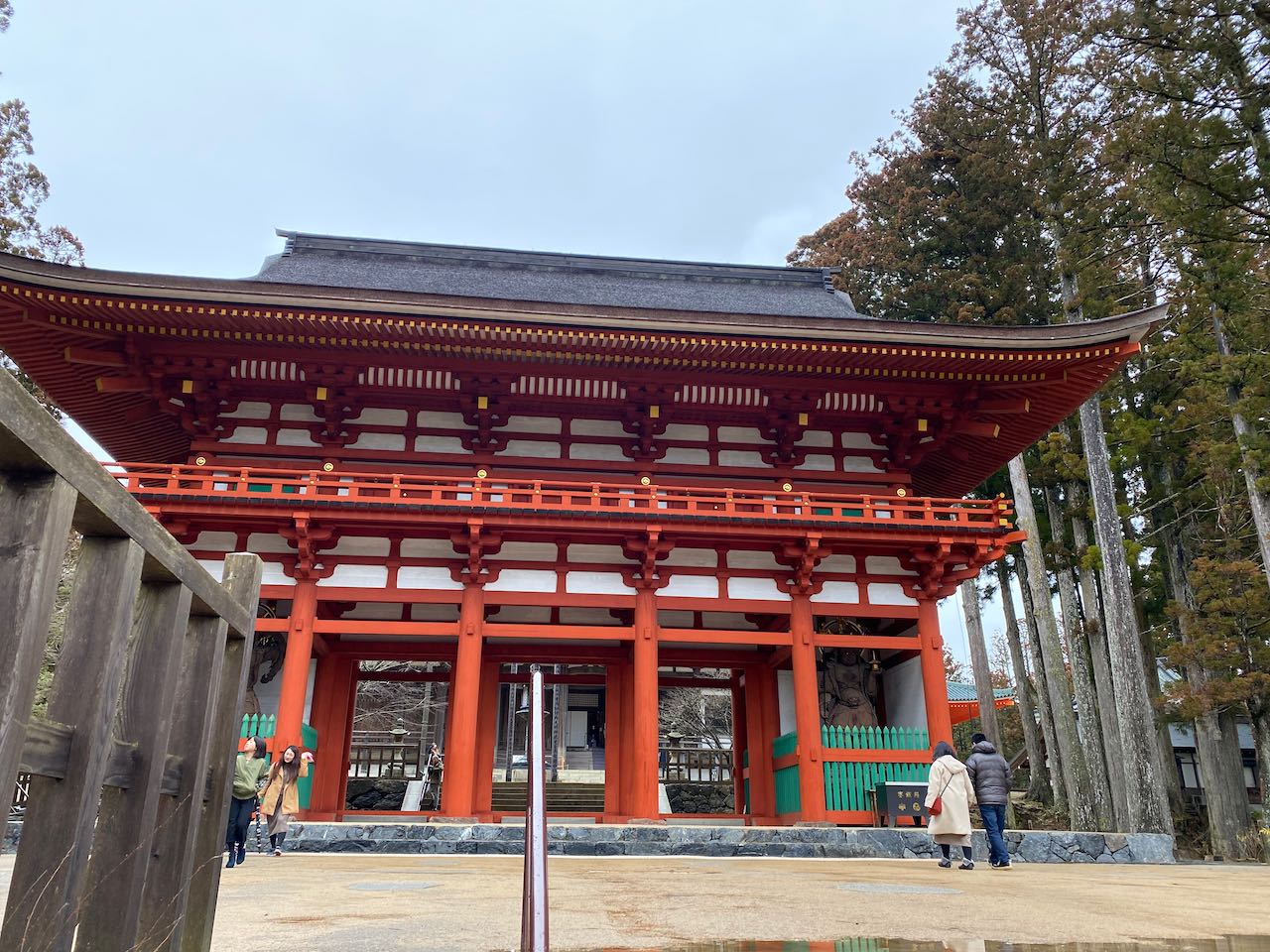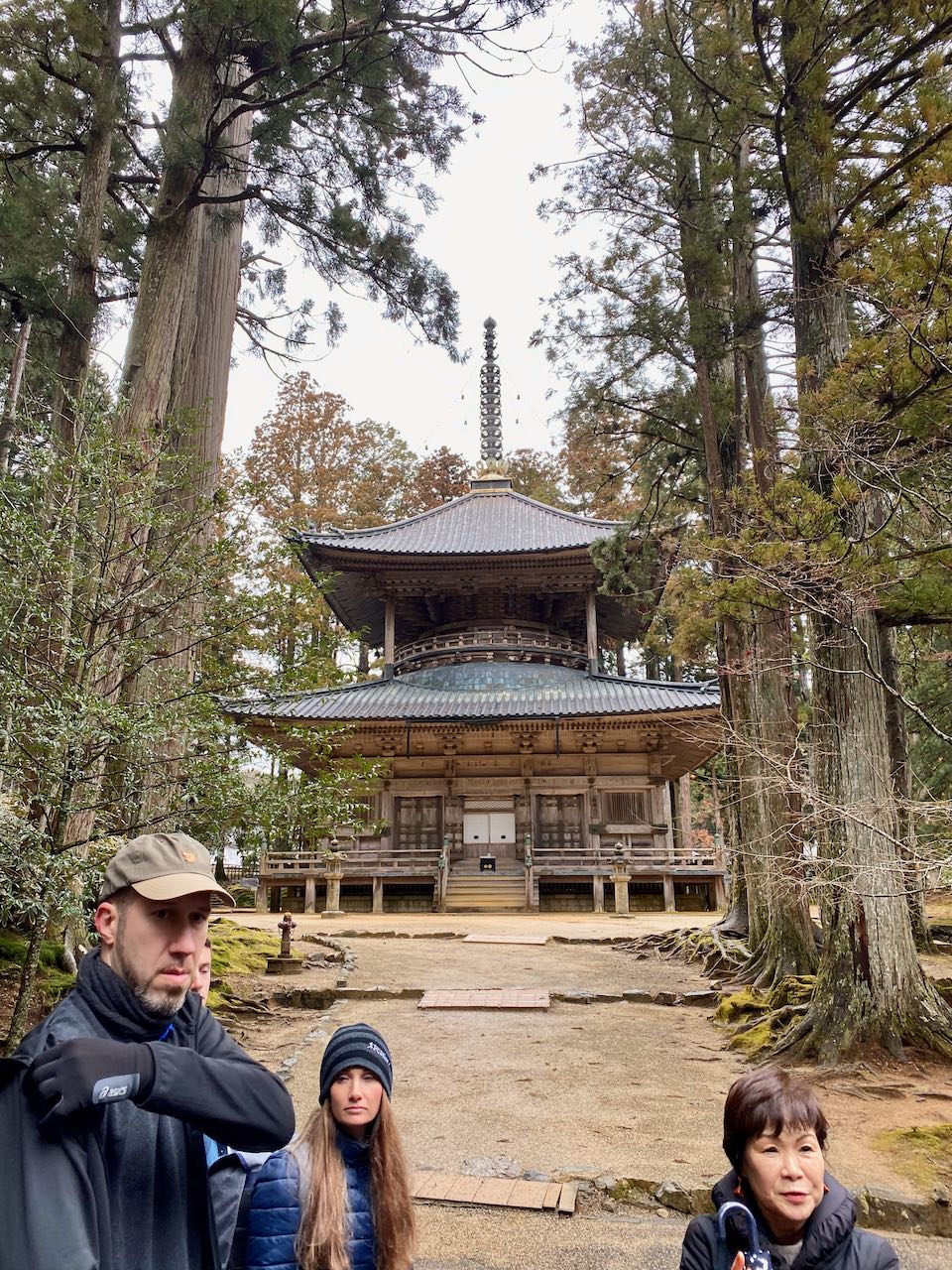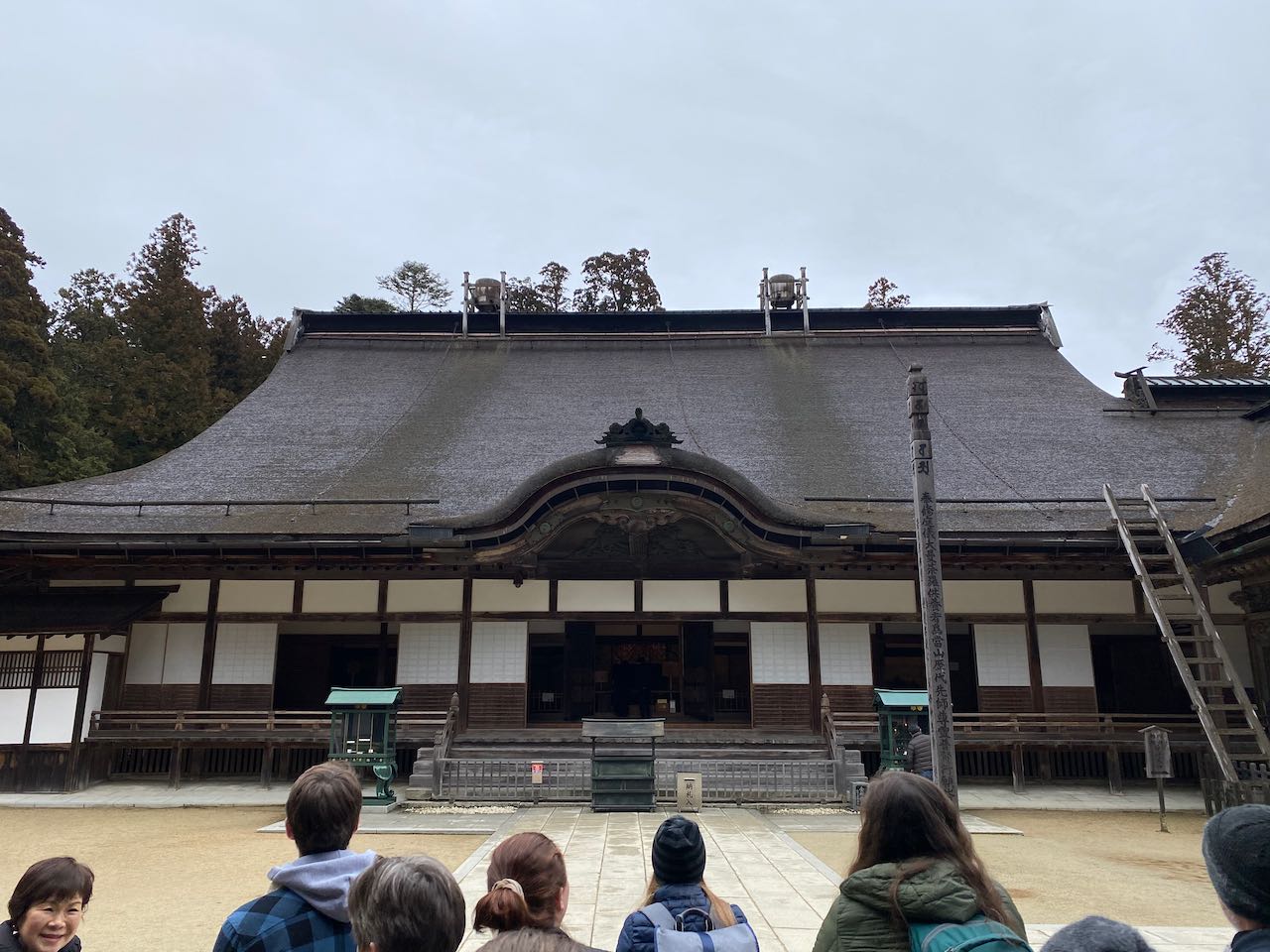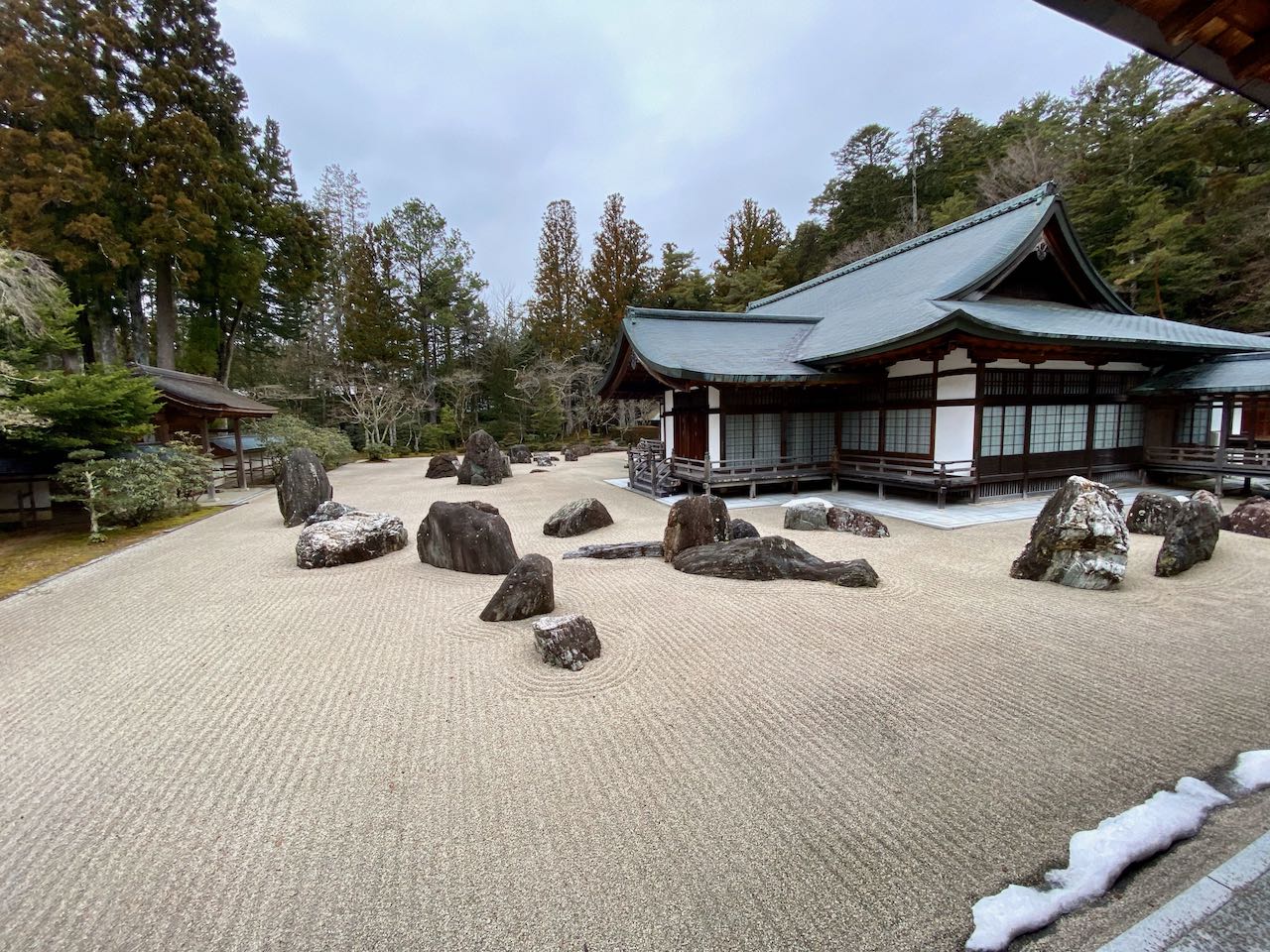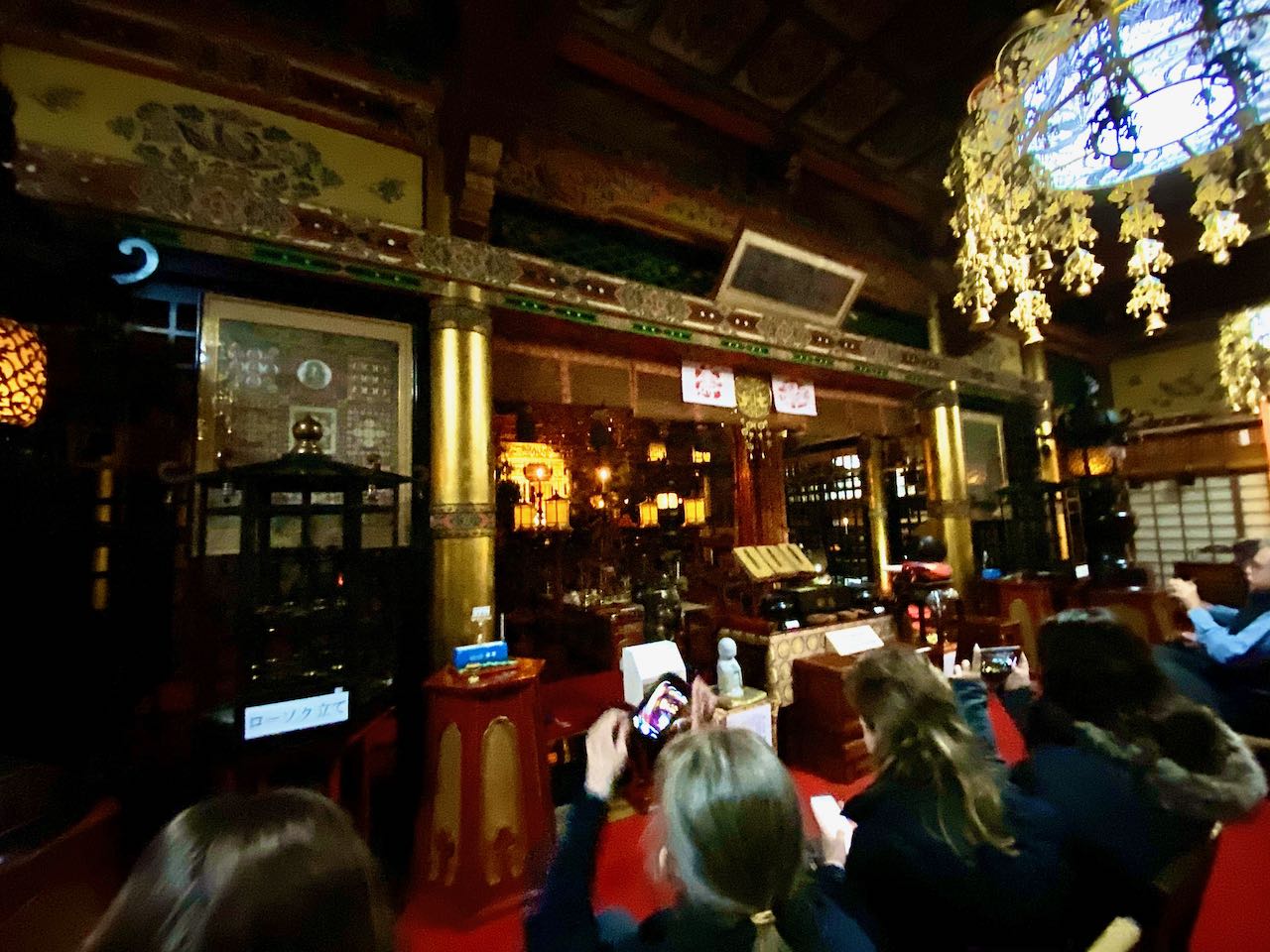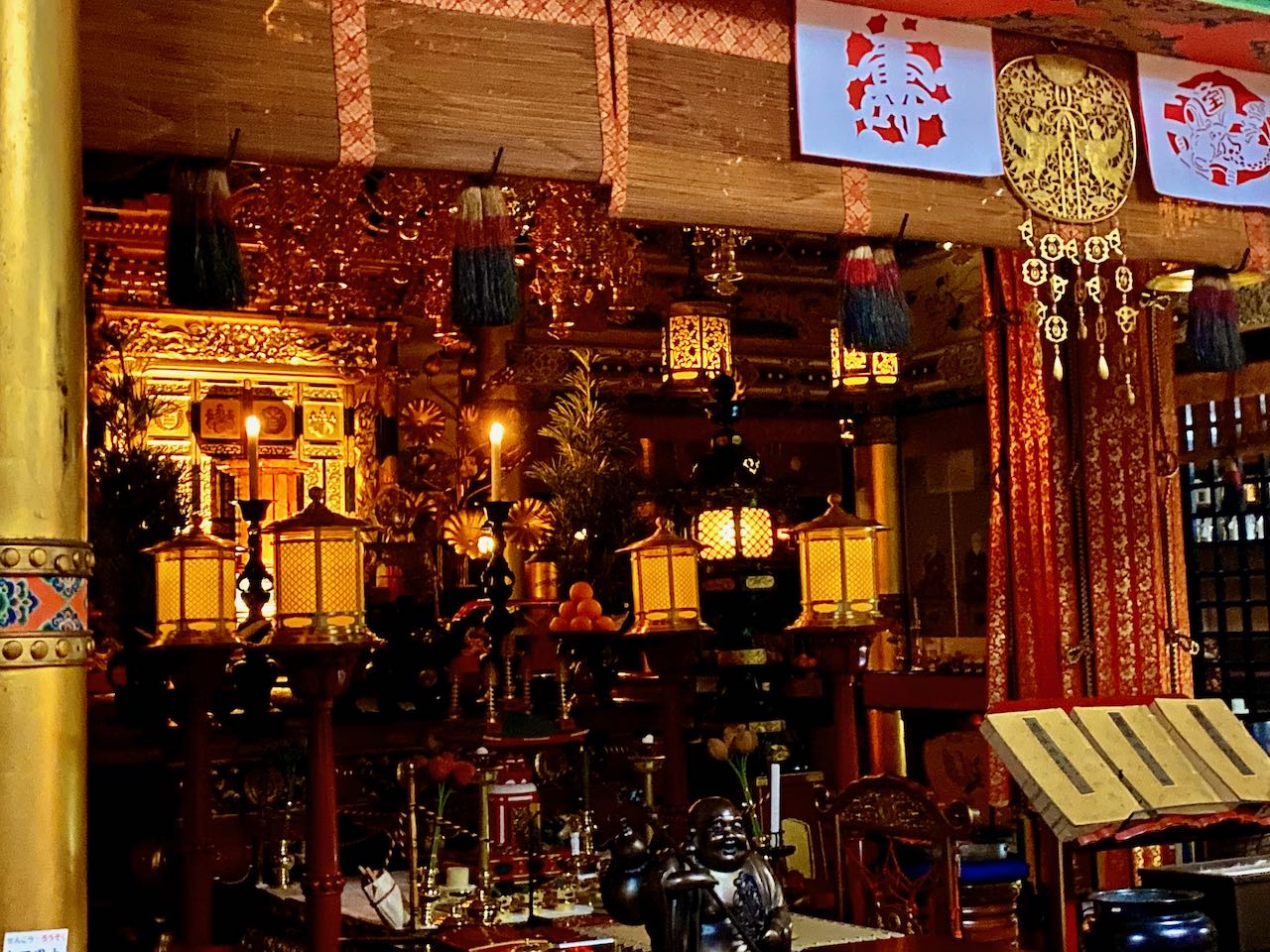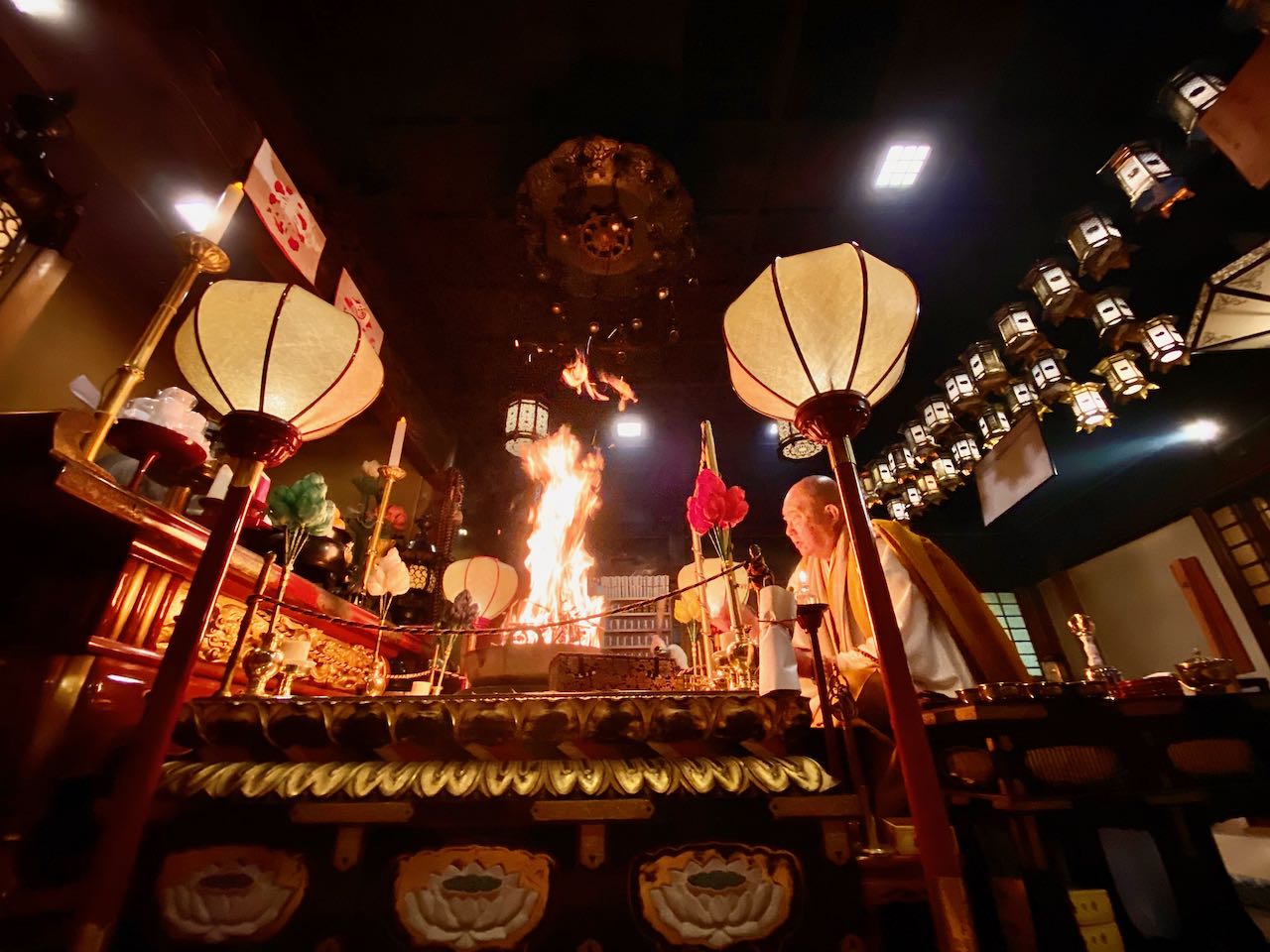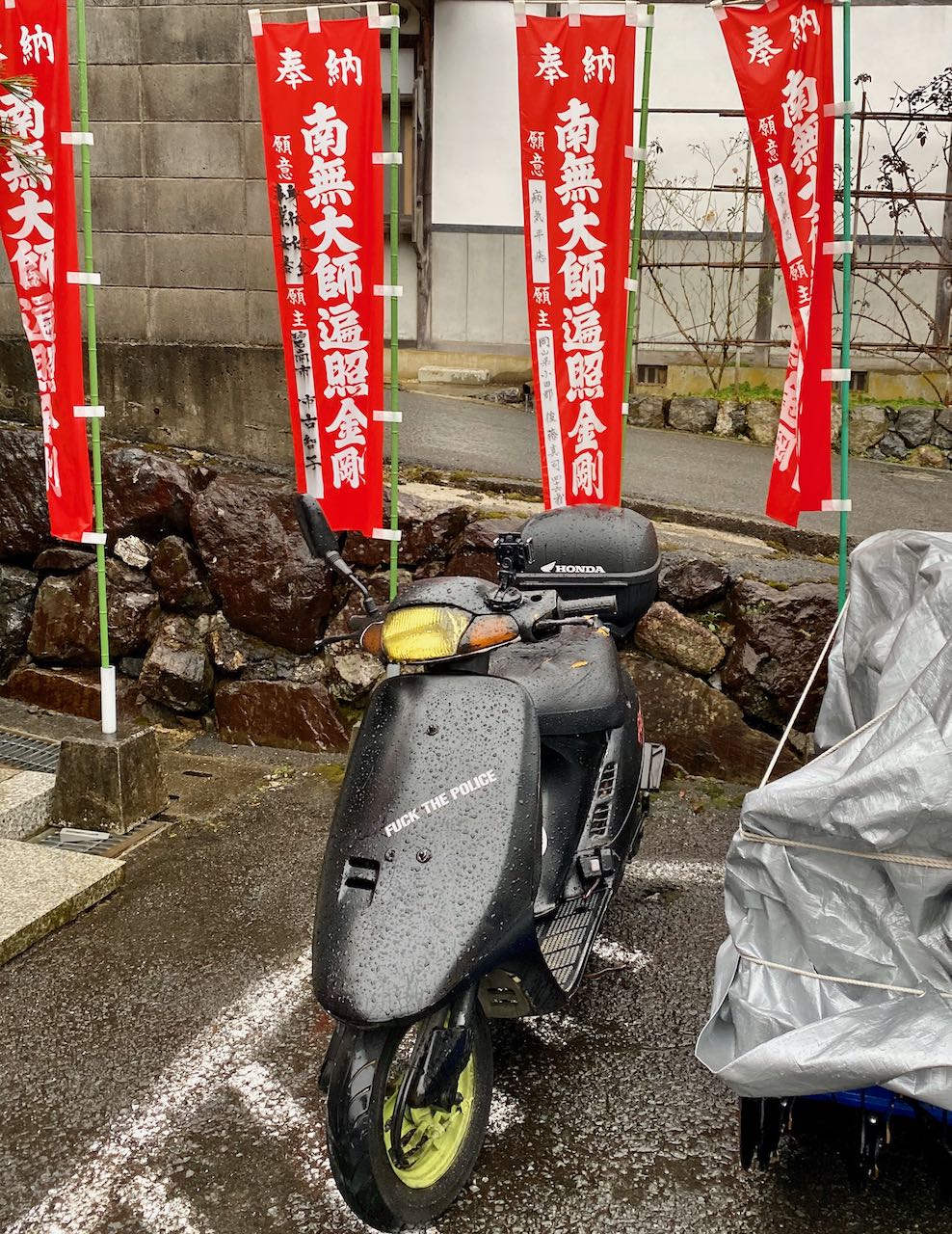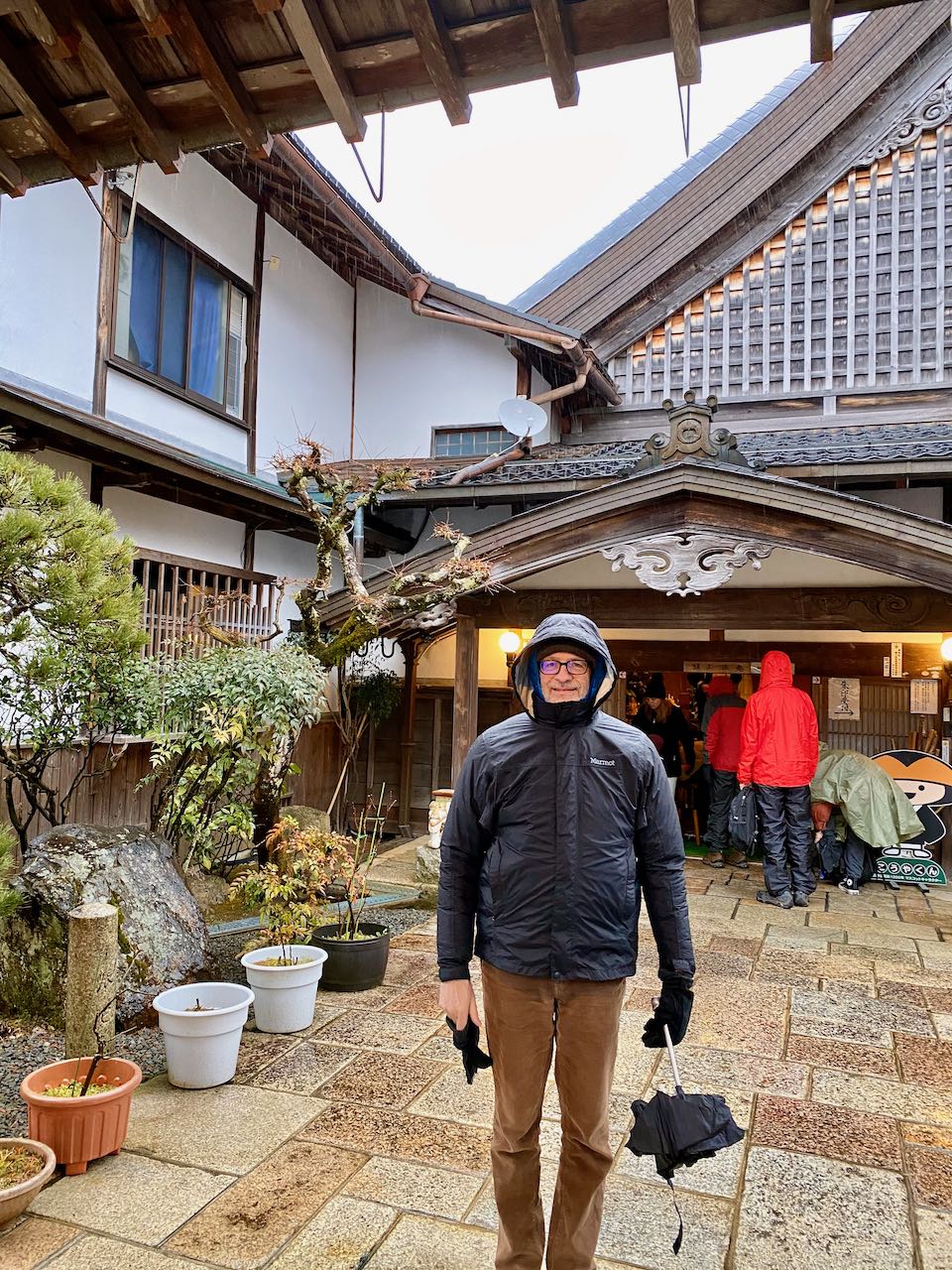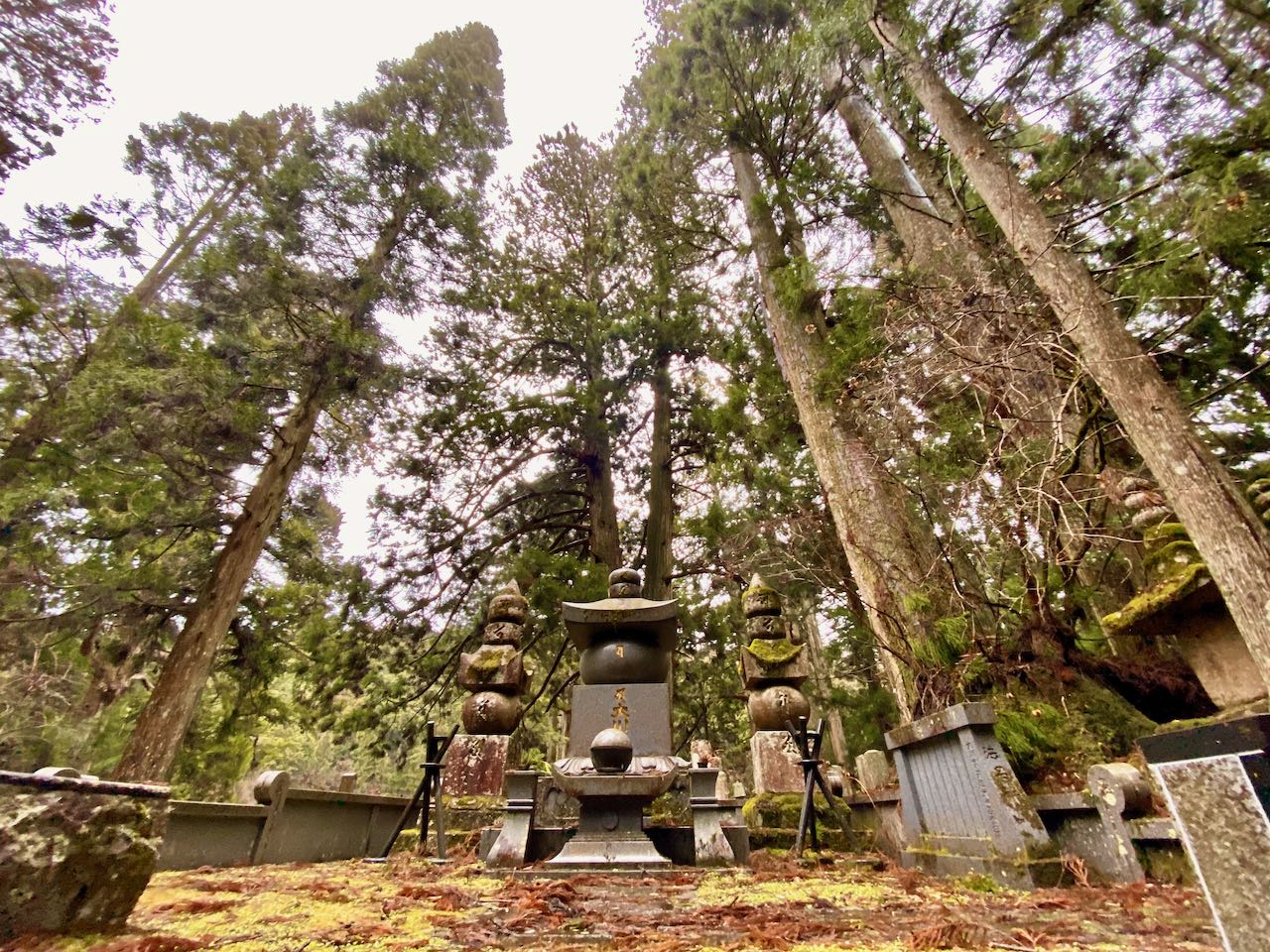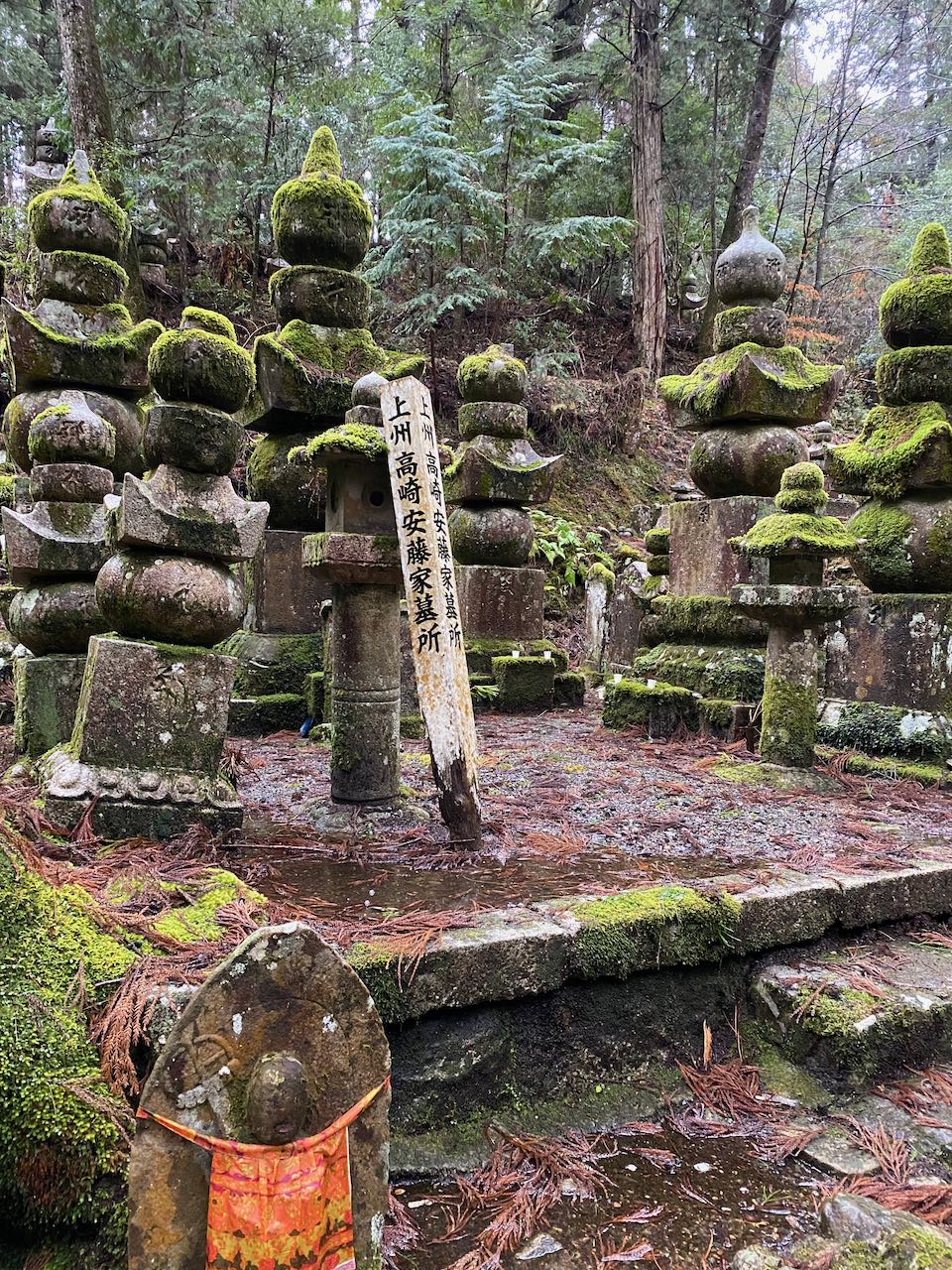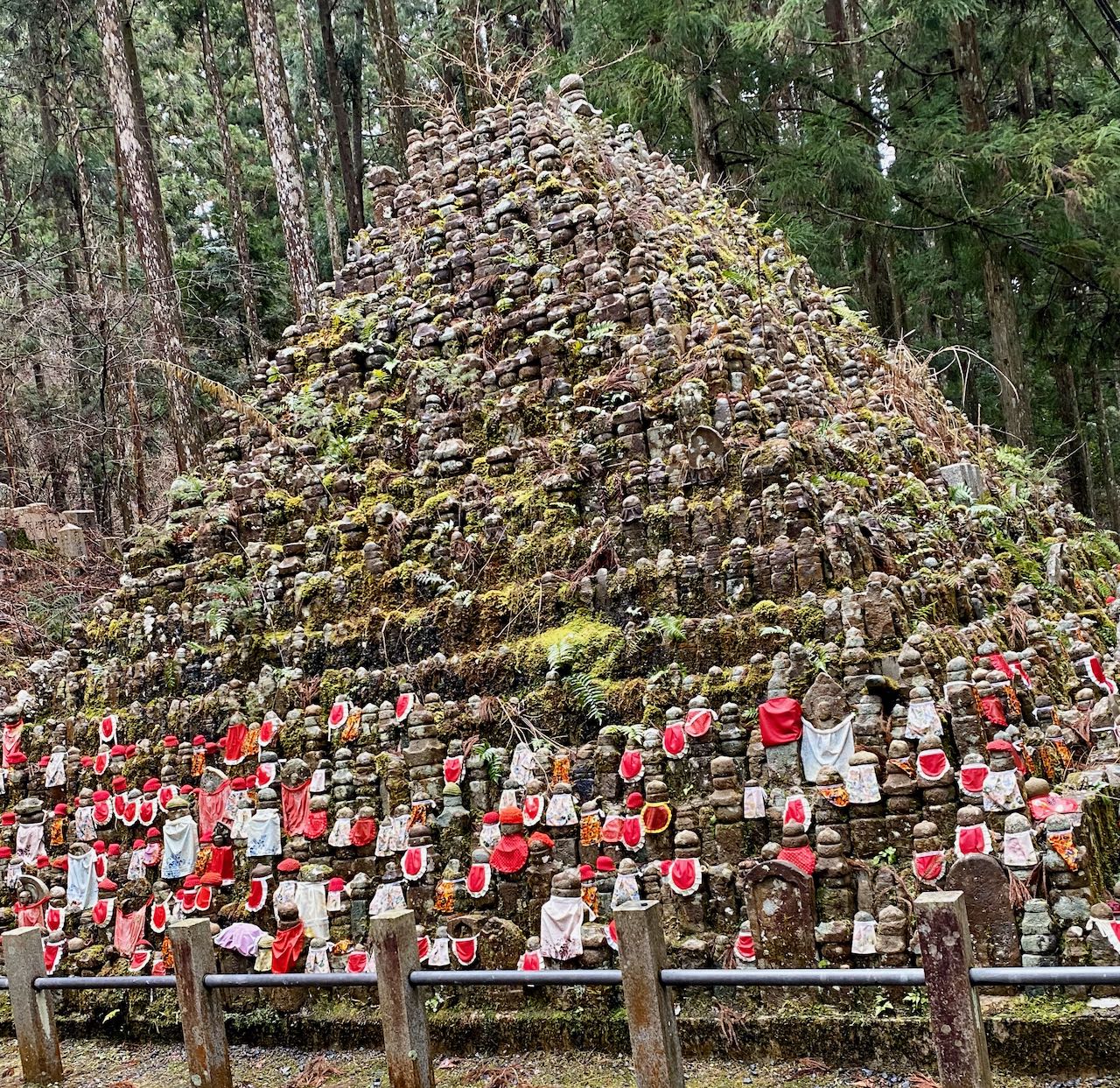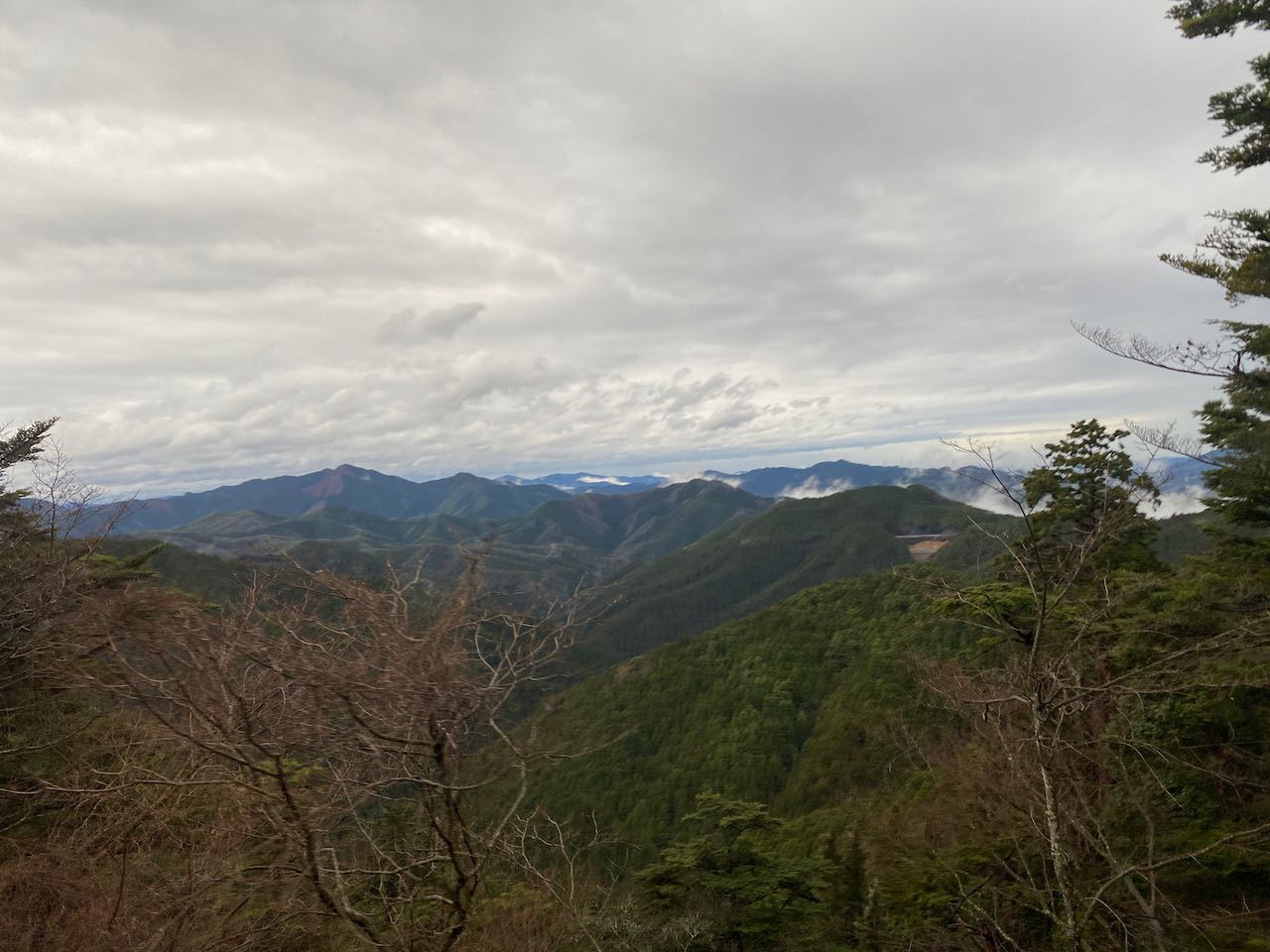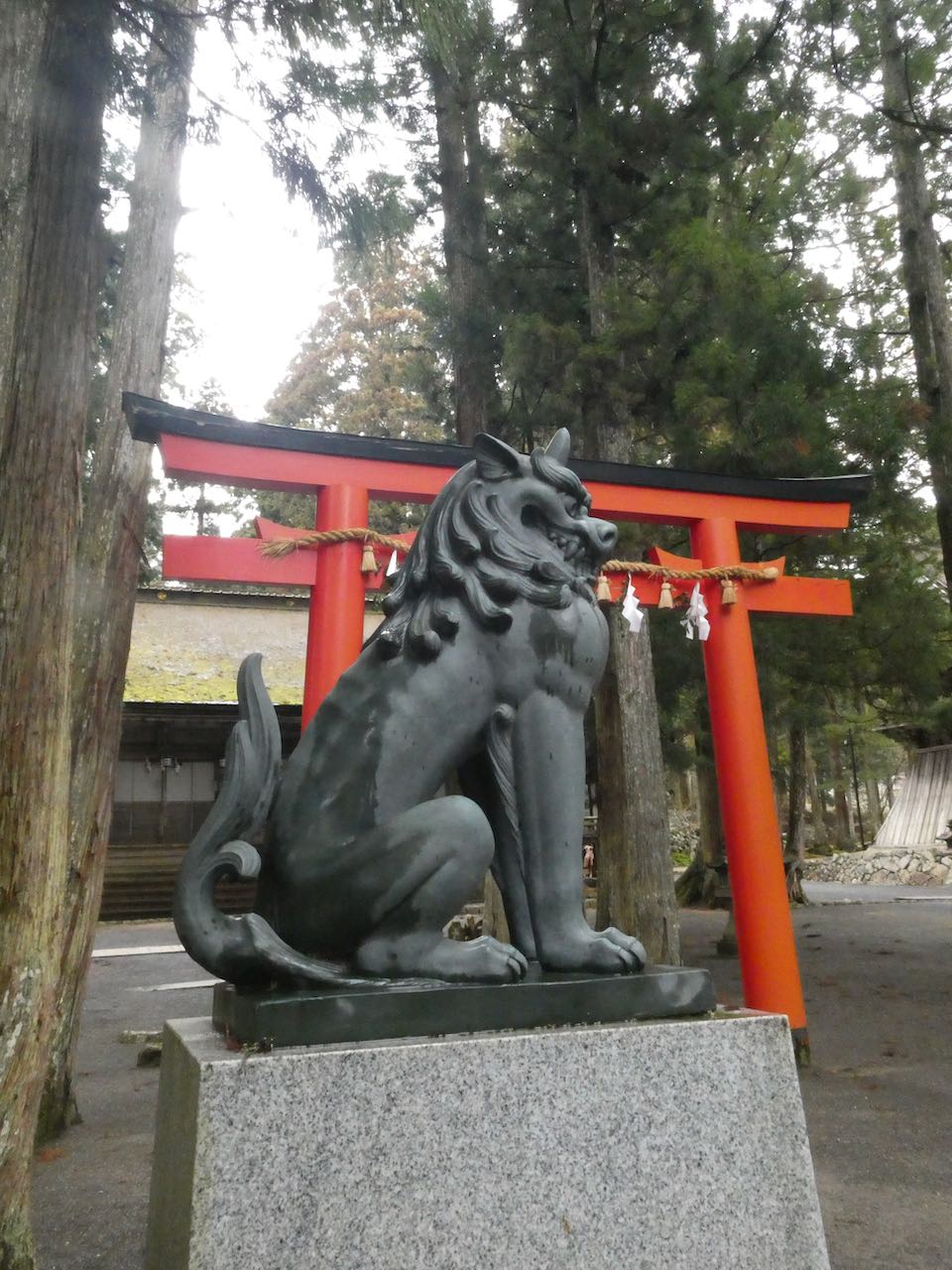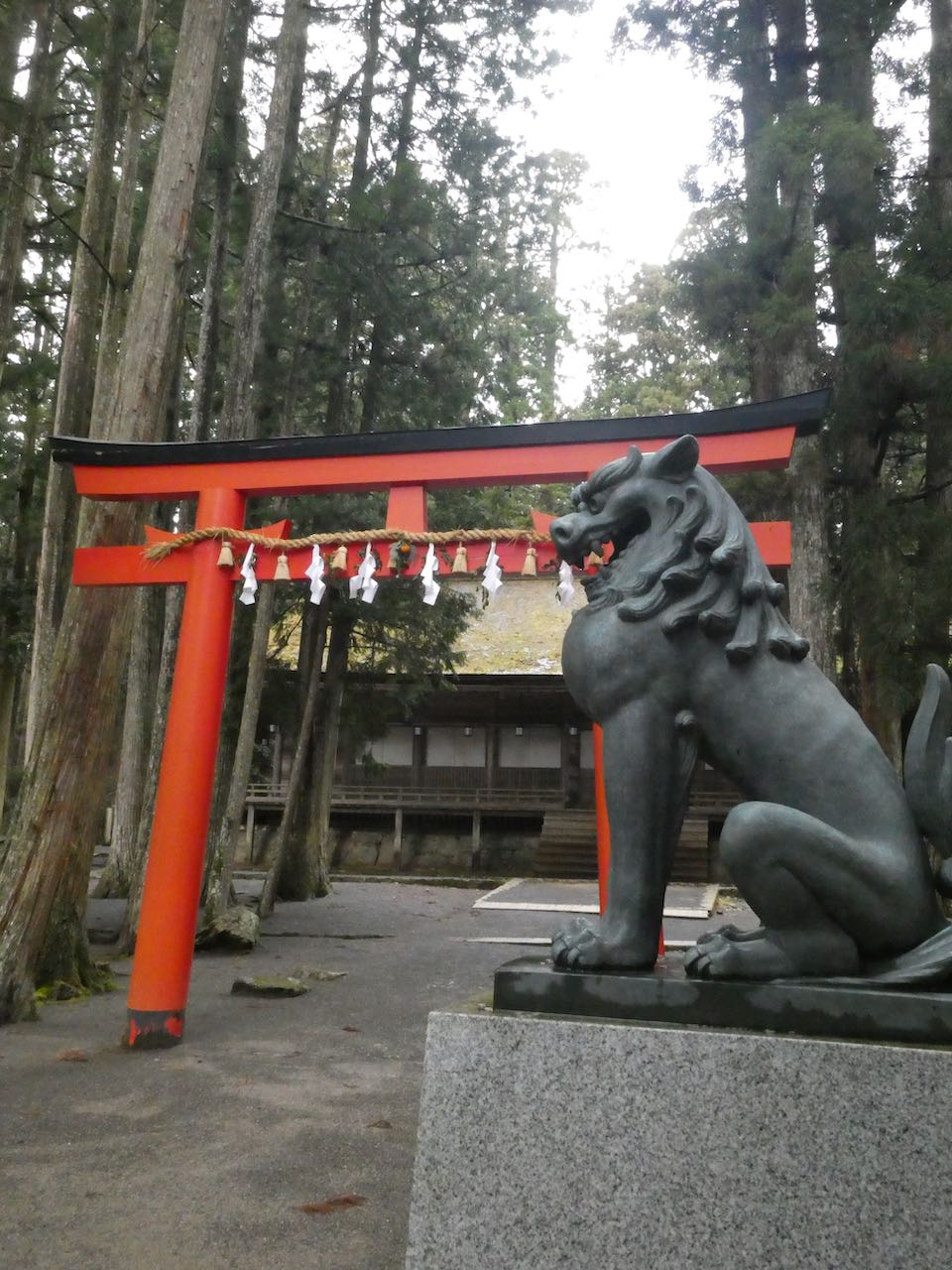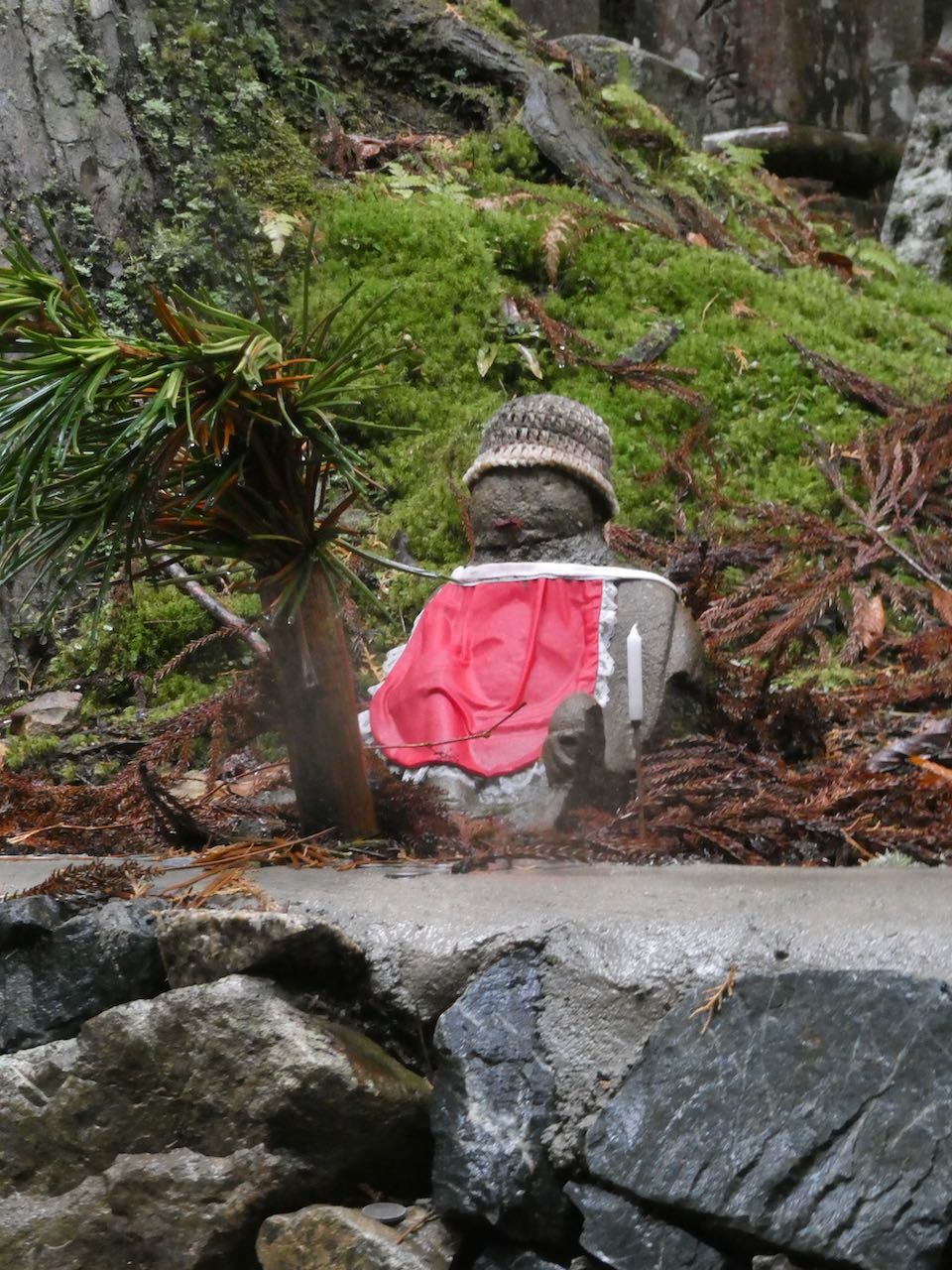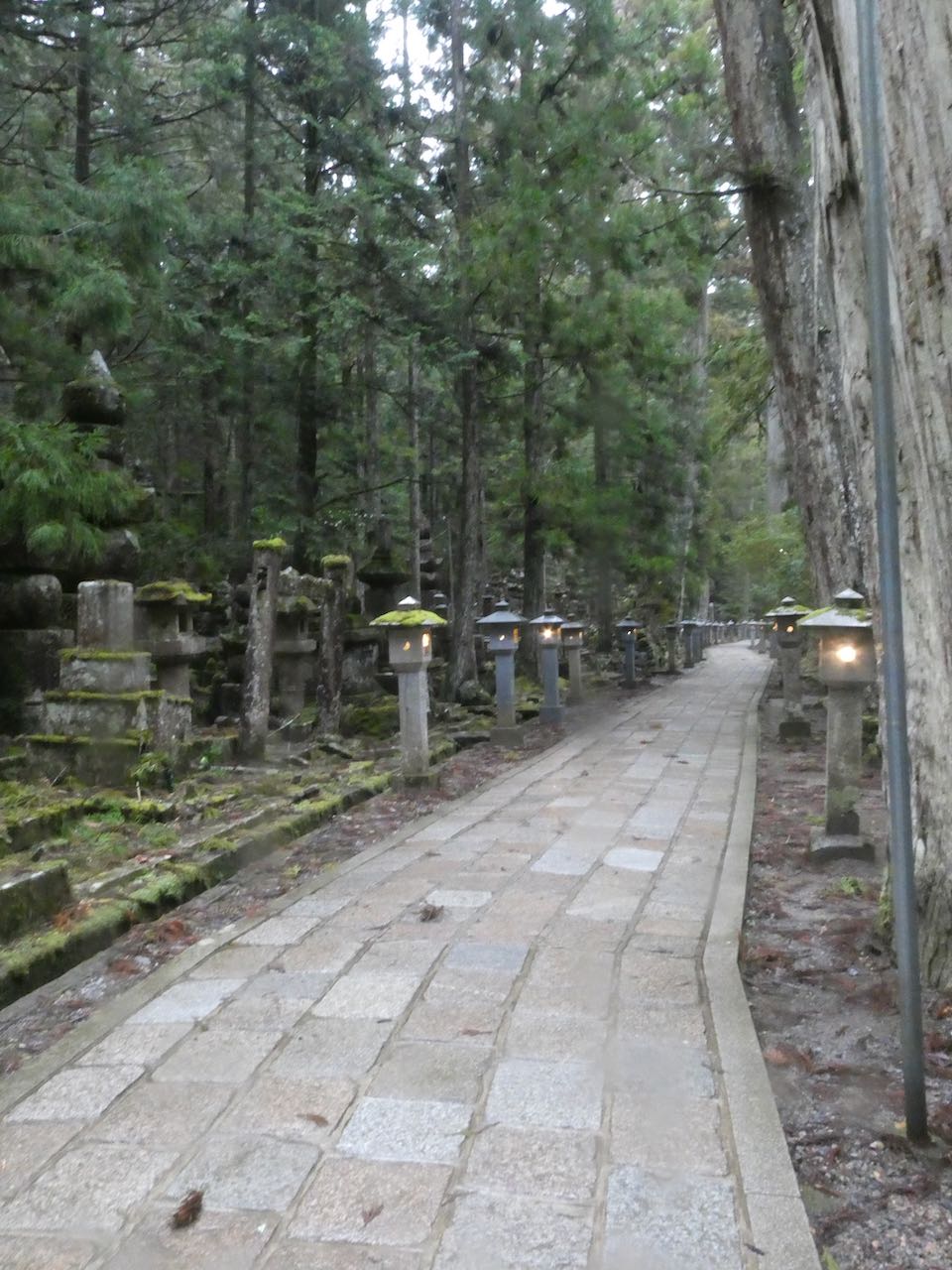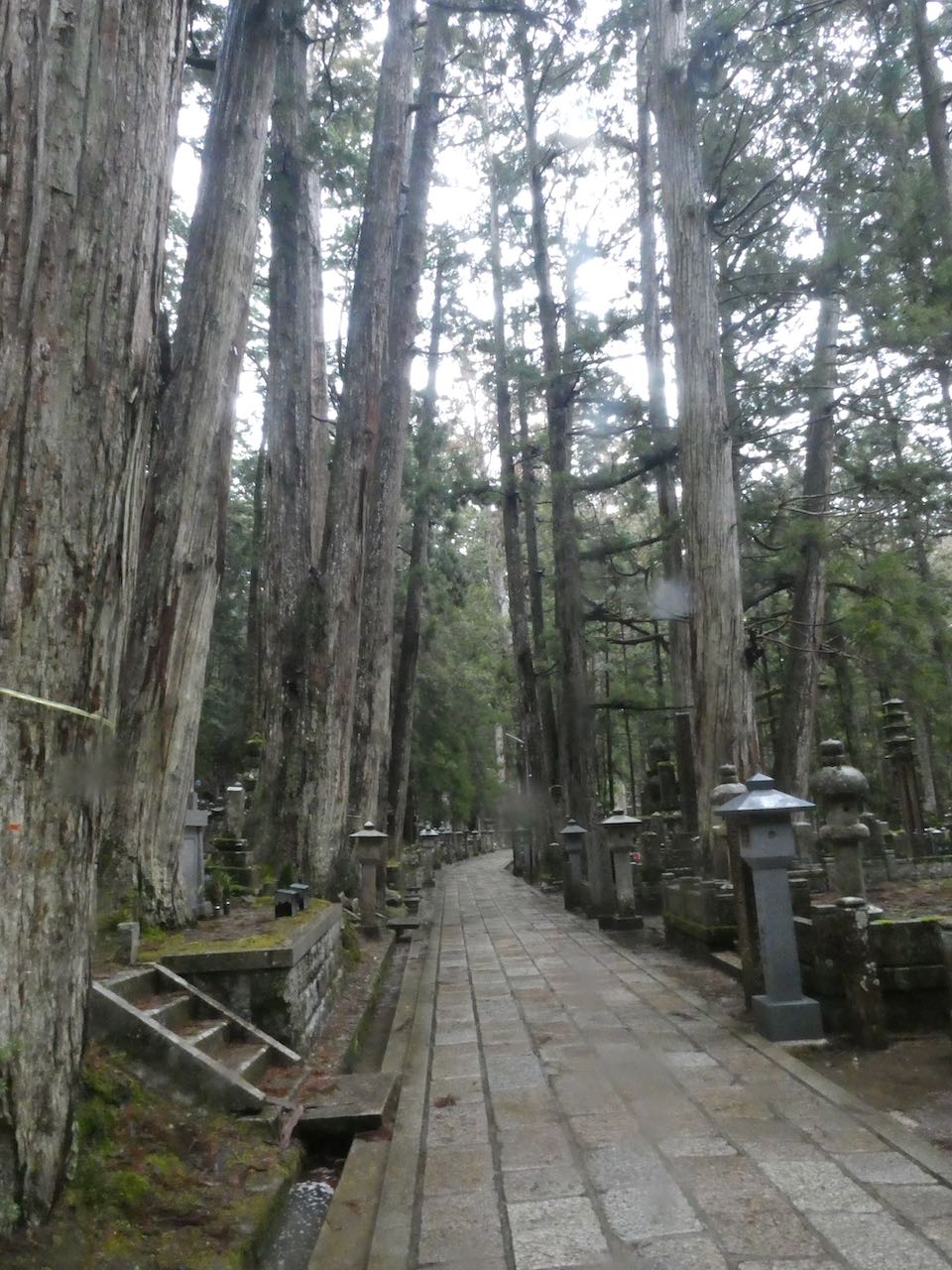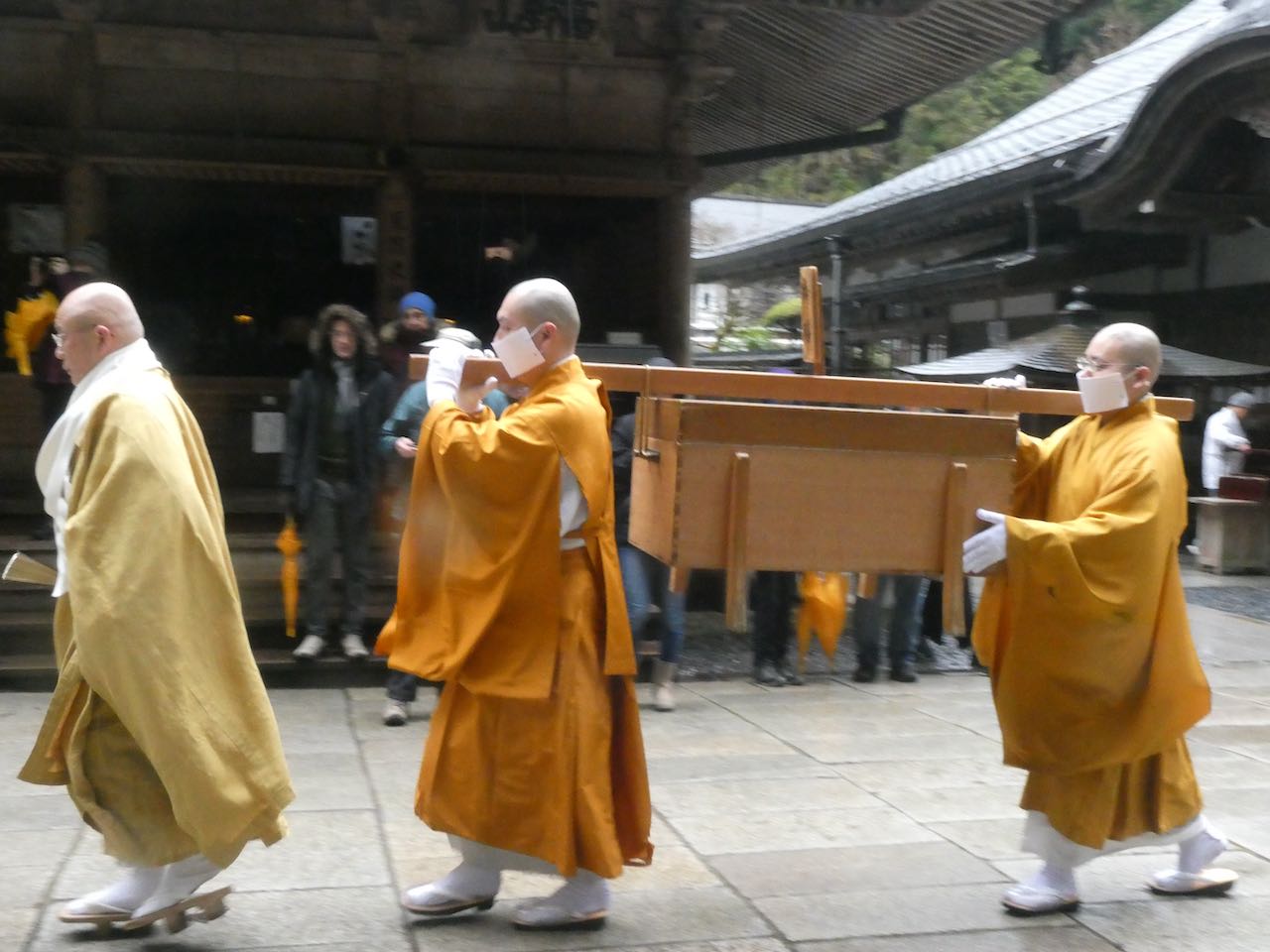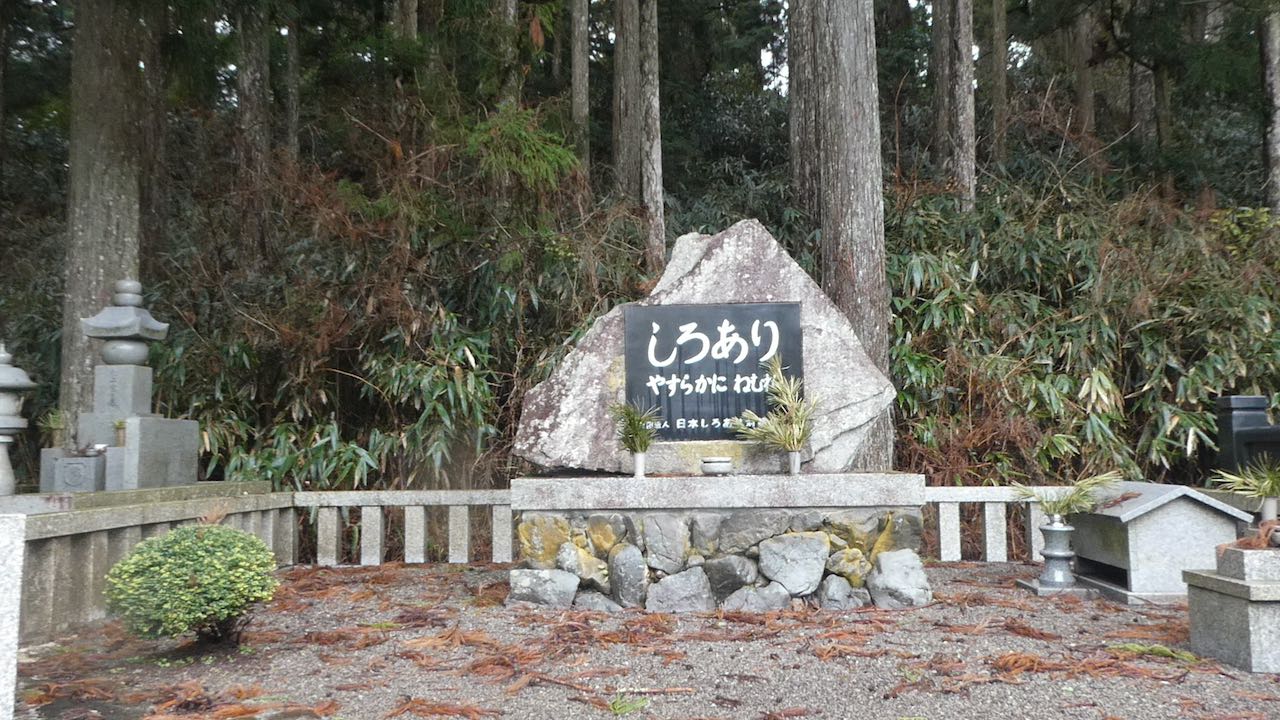January 26-27
[I got behind on my blog while in Japan, and then we sailed back out to sea where we lack connectivity, so this post is 4 days later than the experience described]
The high point of our time in Japan was an overnight trip to the monastery town of Kōya-San. The extremely rural town is located deep in the forested mountains south of Nara. We were able to visit a series of Buddhist temples and gardens, and we were welcomed into a working Temple where we were able to participate directly in ancient monastic practice.
Our experience of Buddhism in Kōya-San was in stark contrast to the festive urban spectacle the previous day. Nara is a teeming modern city with deep historic roots where 21st Century Japanese come in their enormous numbers to celebrate their heritage. Kōya-San is an island in the sky among the misty crags where the touch of modernity is very light. Ancient monasticism suffuses the remote forest outpost just as it has continuously done for more than 12 centuries.
Thirty-three people from Semester at Sea made the trip to Kōya-San. Our group included students and lifelong learners as well as Trip Liasons John Tomescek and Danielle Neid, plus our fantastic local guide named Noriko Matsuyama.
The trip took about three hours by bus. The first two hours were familiar, driving on crowded expressways through the densely developed industrial districts along the shore of Osaka Bay. Then a range of tall mountains loomed and we passed through a series of long tunnels to emerge in a rural valley where crops are grown amid bamboo forests and sold to support the monastery town above.
Finally, we drove almost an hour up an increasingly steep, narrow, and winding road that was often just one lane wide. Luckily there are convex mirrors installed on every sharp curve so that our bus could avoid head-on encounters with oncoming cars. The bus seemed too long for the hairpin turns, and we were acutely aware of the precipitous drops into the forest below. The mountainsides have been extremely engineered with concrete and steel and drainage to prevent mudslides.
Eventually, we arrived at the mountain top – actually a kind of high plateau surrounded by eight even higher peaks. The landscape looks like so many chiaroscuro paintings or drawings of extremely rugged forested peaks shrouded by wind-tattered mist and fog.
We stopped just inside the imposing Dai-Mon gate and filed out of the bus to explore the temple complex at Dai-Garan. This was the first temple constructed on the site.
It was much colder at 3000 feet elevation on the mountain than it had been in the cities. We bundled up in long underwear, sweaters, down jackets, and wool hats. The temperature was maybe 35 F. It was foggy and drizzly. We could see our breath, and the fog in the mountain forest made the whole experience very atmospheric. There were drifts of snow in the shade of some of the ancient buildings.
Our guide Noriko-san explained that a monk named Kūkai founded the monastery in the early 9th Century. He’d been part of an expedition of four ships sent by the Emperor to visit the Tang Chinese court in Chang’an, where he studied an esoteric form of Buddhism under a master named Huiguo. Master Huiguo instructed Kūkai to return to Japan and teach this new form, which became known as Shingon.
In 816, Emperor Saga accepted Kūkai’s request to establish a mountain retreat at Kōya-San as a retreat from worldly affairs. The ground was officially consecrated in the middle of 819 with rituals lasting seven days.
After exploring Dai-Garan and learning about Kūkai, we moved on to the Kongobuji Temple, which is the administrative center for Shingon Buddhism across Japan. We were treated to hot tea and rice cakes and allowed to warm up a bit while we heard a presentation from one of the monks. Kongobuji contains the biggest rock garden in Japan (over 25,000 sq ft), which was very beautiful in the rain.
About 5 PM, we were welcomed to our lodging at Kumagai-Ji Temple where we would eat dinner and then spend the night. It was very cold inside, maybe 6 C – again we could see our breath. We left our shoes at the front door and wore slippers as we followed our hosts to bedrooms on the second floor. Jennifer and I shared a room lined with tatami mats and rice paper screens.
Following instructions, we changed into robes that John called “Japanese pajamas” which we covered with dark blue jackets “because it’s cold.” Then we went down to dinner together in another (much larger) tatami room.
Dinner was lovely, with many separate elements, all vegetarian and most quite delicious. Afterward we were able to enjoy an extended question and answer session with a 25-year old monk. Our students had many questions for this young man – how he decided to become a monk, what his training involved, how he spends his days and nights, whether he can (and wants to) marry and have children, and what he does on his off hours.
About 9 PM, we retired to our tatami room to sleep and found that the monks had prepared a great little nest with futons and thick comforters – very comfortable! There was a portable gas heater set up in our room too, so it was quite warm. We found that with the thick comforters, it was too warm to run the heater, so we turned it off and went to sleep.
When the alarm went off at 6 AM, it was still 11 C (about 52 F) in the bedroom. We dressed warmly and went downstairs, where it was much colder – about 2 C. There was steady cold rain outside.
Our group gathered, sleepy but excited, shuffling down the stairs and hallways in our slippers. The monks ushered us to the main hall for “Morning ceremony.”
The hall was beautiful – suffused with a golden glow from candles, lanterns, and gilded statues. The warm smell of incense filled the bracing air. We stopped at the entrance to purify ourselves by rubbing a pinch of Indian spices in our palms, so that the scent would envelop us. Then we sat in two rows of low chairs.
The four resident monks began chanting – rhythmic and melodic in a strange key, lower registers. The chants were punctuated by sounding a gong, like a singing bowl.
The warm golden glow of the hall and the chants were deeply comforting in the cold air. I felt the warmth of the people around me. The overall effect was like being in a dream.
As the chanting continued, we were each invited in pairs to the front of the hall by the Master. Each of us did a prayerful bow, then three times took a pinch of incense, touched the forehead with it, then placed it on a heated surface where it glowed and smoked. Then with a final prayerful bow we returned to our seats.
Morning Ceremony took about 30 minutes, after which we were escorted to another hall for a fire ritual. By then it was 7 AM. The hallway was open to the rain, alarmingly cold.
In broken English, the Master told us all to kneel on the tatami. The group was split – half to each side of a large altar where the Master sat on a platform. Again, the monks began to chant rhythmically and again the singing bowl gong was sounded.
The Master assembled a framework of wooden slats in a large bowl and poured some kind of flammable liquid onto them. As he lit the fire, one of the monks began sounding a complex rhythm on a large taiko drum.
As the fire grew, the Master kept piling more and more wood with a set of tongs and more oil with a long spoon. The ceremony built dramatically with chanting, drumming, and crackling flames no more than 6 feet in front of me.
Some of our group had prepared written prayers or wishes on wooden staves. The Master invited them to approach one by one and pass their prayers under a ceremonial rope and into the growing fire.
As more and more prayers were fed into the fire the flames grew to more than 5 feet tall. Flames were licking the hanging gilded ornaments, making them jingle like wind chimes. The drumming and chanting reached a crescendo as the last of the prayers were released.
The ceremony ended about 7:30. It was hard to get up as my feet were quite numb underneath me. We followed the monks, shuffling in our slippers through the cold hallways to the tatami room in which we’d eaten the night before.
Breakfast was quite good. All vegetarian, with rice, soybeans, vegetables, pickles, seaweed, tofu, and green tea. Afterward we returned to clear out our sleeping rooms and then check out of the lodging.
Our temple stay was like nothing I’ve ever done before. We were welcomed into monastic practice and experienced the intersection between the 9th and 21st Centuries. The monks carry on with practices established on the spot more than 1200 years ago, yet adapt to maintain and finance the Temple and recruit young people in modern Japan. As we gathered in the steady cold rain after checking out, I noticed a motor scooter parked at the Temple with a bumper sticker on it that said “Fuck the Police!” I wonder if it belongs to a monk?
We spent the rest of the morning walking through the Okuno-in cemetery. I wore every bit of warm clothes I’d brought from Colorado for this day: long underwear, sweaters, a puffer jacket, a winter coat, a waterproof shell, wool hat and gloves. I needed every bit of this, as we spent the next two or three hours in the bracing cold and wind-driven rain.
Secreted away on a mountaintop deep in the countryside far from the bustling cities, the cemetery is the largest in Japan with more than 200,000 graves. It’s such an honor to be remembered here that prominent families from all over the nation have memorialized their loved ones here for more than 1200 years.
Walking through the cemetery in the rain was beautiful and evocative. Huge cedars dripping and whispering in the wind, some of them more than 10 feet across. Grave markers covered in moss, some crumbling in disrepair and others freshly installed.
A repeated pattern with thousands of markers included a stack of five stone pieces, each representing one of the five elements of the world: a rectangular block representing Earth; a spherical stone representing water; a rectangle with upturned corners representing fire; a cylinder representing air or wind; and a teardrop shape Kōya-San representing space. Noriko-San explained that every pillar is topped by the one element we can’t see: consciousness!
In the cold mist, we walked the ancient graveyard as the wind flowed through the towering cedars above us. Many of the smallest markers were adorned with red bibs and hats. Noriko-San explained that these marked the lives of children. Traditionally, those who die before they understand religious teachings don’t know what to do in the afterlife and stand crying at the bridge to the next world. Visitors drape their markers with cloth to keep them warm in their sorrow.
We walked for two miles through the cemetery in the cold rain and wind, and then were taken into a warmer tea house to rest. Noriko-San explained that at 10:30 the monks would “feed” Kūkai in a daily ceremony.
Kūkai (known posthumously as Kobo Daishi) is said to have entered “eternal meditation” in 835. He passed into a cave where he is believed to be still alive and tirelessly striving to aid all beings. We watched three monks prepare Kobo Daishi’s meal and process into his mausoleum with the ceremonial food on their shoulders as they chanted.
We stopped at the mausoleum and offered our respect before assembling in a spare restaurant for lunch. Then we boarded our bus and began the long and extremely steep descent of the mountain. After an hour we once again reached the valley whose crops support the maintenance of the monastic village. Then we passed through the base of the mountain range again via the modern tunnels and rolled into the industrial port districts of the great Osaka megalopolis.
Finally, we were welcomed back aboard our ship and returned to our familiar cabin on deck 8.
What an incredible experience! I have been to Japan perhaps half a dozen times over the years, and have always been deeply impressed by the beneficent organization of society, the efficiency of the infrastructure and the kindness of its people. I always sensed the deep identity and reverence for the past, but I had never before experienced the depths of ancient and medieval Japan.
Though very secular, there is a spiritual foundation under Japanese culture that I now feel privileged to have seen.


